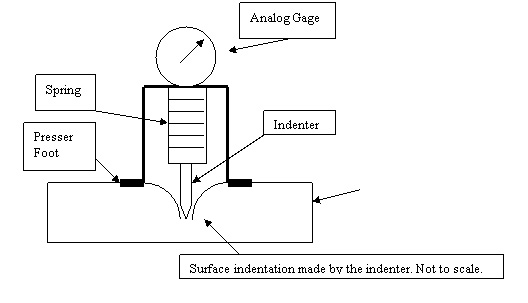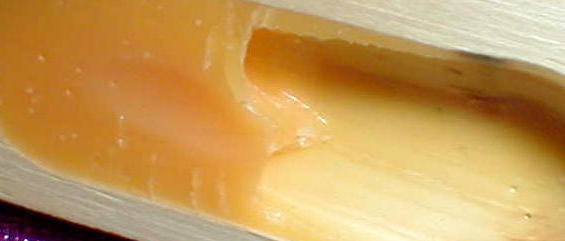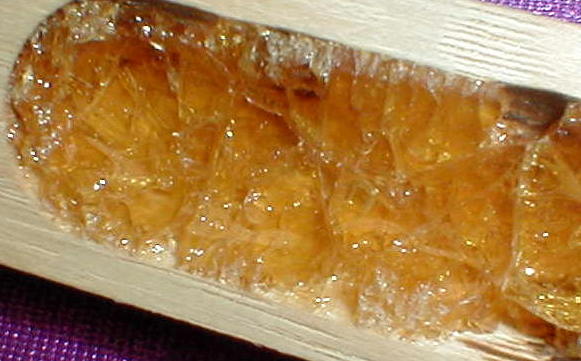Hot hide or animal glue has been around and used for centuries. It was the glue of choice for early furniture makers and luthiers alike. It has a mystique to it just when you mention the name. Many luthiers use hot hide glue on their instruments but I was actually intimidated by the thought of the entire process. After several trips visiting Frank Ford’s website, studying his testing and repair techniques of using hot hide glue, I finally had enough encouragement to convince me to try this glue.
Previously I took the easy way out and used Titebond Original Formula yellow glue. It is readily available, easy to use and the joints are reversible. However, after switching to hot hide glue a discernable difference was heard. My guitars took on a completely new ambiance. The volume and sustain increased, they seemed more responsive and lively. My hypothesis was that when I used Titebond on my previous instruments that some glues may actually dampen the string energy transference throughout the joints of the instrument but I had no valid proof.
I had a strong suspicion that the change in the sound and energy of my guitars may have had something to do with the hardness property of the hot hide glue. So, I set out to test all of the common glues available to luthiers to see which glue is truly the hardest and to see if there really is a measurable difference in the hardness.
Please keep in mind that this is only one test and one property of the glues mentioned in this article. This test has absolutely no relavance on glue strength or many other factors that a luthier should consider when selecting glue. However, I am now convinced that the glue used on an instrument has a direct relation to sound, volume, vibration dampening and the overall deadening of an instrument.
I think the definition of the common words below shed new light as I followed my quest to improve my guitars by choosing the glue I use.
DAMPEN
DEAD ‘EN, v.t..
We all know that when we tap a brass cymbal and then tap a piece of wood there is a huge difference is volume, sustain and tone. Did you ever wonder why or question why they make cymbals & bells out of a hard material instead of a soft material? We even notice small differences between tap tuning soundboards within the same species. What is the auditory feedback really telling us? Hardness and density influences volume and sustain, doesn’t it? Although I don’t claim to be an expert on this subject my testing has shown me that glue hardness is a factor perhaps we should consider. Sure some material can be hard while at the same time they can be more dampening than other materials.
Imagine if you took two cymbal halves and placed a foam gasket between them and then struck them with a drum stick. The foam would dampen their ability to ring and sustain. Now imagine that two cymbal halves were welded together with a very hard brass filler metal and then you strike them with a drum stick. They would ring again and quite possibly even louder and longer due to the increase in mass and lower dampening of the filler metal used to join them together.
Can we relate this theory to the instruments we build? Imagine attaching the top braces to the top but use a rubber gasket between the braces and the top. The rubber is going to absorb energy and dampen the sound board. However, if we attach the braces with a very hard glue this will not dampen the energy [as much] as if we used a much softer glue. Think about other critical joints of the instrument: The bridge, top to rim set, back, neck joint, fingerboard… It’s the little things we do in our craft that contributes to the sum of the whole package.
To test the glues I took a piece of Ash and milled out identical cavities in which I poured the glue I intended to test.

I poured the glue to a depth of 1/8″ and allowed it to cure for 15 days. I then poured a second layer in the cavity to a depth of 1/8″ and allowed that to cure for 15 days. Next I ran the wood & glue through my thickness planer so I removed barely enough glue to expose a consistent flat surface. Then the glues were allowed to cure for two more weeks before testing.
A second set of coupons were prepared using glass as a substrate. Using the same methodology as above I formed a dam of masking tape and then poured glue into the dam area. I though I might get variance in the measurements by using two different substrates. I was wrong as the measurement data sets were almost identical.
To measure the glue’s hardness I used a Shore D Durometer Hardness tester which is a handheld instrument that uses a spring loaded conical cone or indenter. The indenter measures distortion on the surface of the sample coupon when the presser foot is held firmly against the surface and pressure is produced by a spring load.
A Durometer Hardness Tester is an easy to use, ISO and ASTM certified gage that quickly and accurately measures the hardness properties of various types of materials or test coupons. The small, handheld device can quickly measure, (usually within 1 second), the hardness properties of the desired coupon sample by firmly holding the Durometer to the surface you wish to test and manually applying pressure to the presser foot. The resulting value on the analog scale indicates the “hardness” of the material in relation to other material characteristics. The non-destructive testing method and compact size make the Durometer Hardness tester an ideal measuring instrument when elaborate sample preparation and testing is not feasible.
The sample coupon (or glue) produces a resilient force against the pressure load. The “hardness” means the depressed amount of the indenter at the time when the resilient force becomes equal to the pressure load. Thus, the value will consequently reflect the “physical amount” with no unit. This gage just provides a measurement system to compare one coupon’s hardness to another.
The diagram below shows the components of a typical analog Durometer.

The diagram below shows the components of a typical analog Durometer.
LMI HIDE 82-81-81 Cracks if too thick, chips during machining, range of 1
LMI WHITE 80-78-79 Minor porosity, chips during machining, range of 2
TITEBOND White All Purpose 80-78-78 Surprise glue of the test. Exhibits shrinkage, range of 2
ELMER’S WOOD 72-68-78 Chips during machining, range of 10
TITEBOND Original 80-52-71 Separates when machined, won’t bond to itself, range of 28
LOCTITE EPOXY 75-65-70 No porosity. No chips during machining, range of 10
LOCTITE C/A Professional 70-70-70 Some porosity visible, range of 0
StewMac 20 C/A Medium 82-81-81 Much clearer, range of 1
DAP (WELDBOND) 75-45-60 Small chips during machining, range of 15
ELMERS WHITE 75-30-60 Some porosity, dents with fingernail, range of 45
ZPOXY Finishing Resin 70-68-69 Very clear, no porosity, range of 2
GORILLA 0-0 0 0 Very soft with the consistency of a sponge
The goal was to test all of the common glues available to luthiers, to determine which glue is truly the hardest and to see if there is a measurable difference in the hardness. The results indicate that LMI’s hot hide glue is the hardest of the eight glues tested. Hide glue also had a low range of 1 indicating there isn’t much variation in the glue. While LMI’s white instrument glue had a low range of 2 and hardness just 2 points below hide glue. The third pace finisher is Titebond all purpose wood glue with identical numbers of LMI white but it exhibited slightly more shrinkage.
The Gorilla Glue was the oddest of all the glues tested. It was so soft it wasn’t even measurable. The porosity was that of a large open celled sponge.

Granted, procedures in this test were not according to the manufacturers suggested use. Gorilla Glue is supposed to be applied to one surface and the other mating surface is to be moistened with water (which I did) and then both surfaces are to be clamped together (which I did not do). However, I believe that this test indicates that this glue is considerably softer than all of the other glues tested. It reminded me of the density of a Styrofoam cup.
Based on the results above, there truly is a measurable difference between all of the glues. This comparison gives luthiers more data to consider when selecting the appropriate glue for their instrument. I was not compensated or influenced by any OEM or distributor and this testing was done with an unbiased opinion.
Another side point that was learned is that some glues will chip during machining and actually delaminated from the two applications within the cavity.

Titebond was the most surprising as a large chunk of it broke away from the first layer of glue. This tells me that this glue doe not adhere well to itself. Remember this when re-attaching a bridge folks!
Hide glue will crack, craze and crystallize at less than 1/8″ thickness.

This reinforces the importance of using hide glue only in a well fitting joint. You should never rely on hide glue to fill any voids or gaps.
There were some late additions to the test which included: Titebond All Purpose White glue, Loctite Super Glue, StewMac 20 Medium super glue and Zpoxy finishing resin. The surprise glue of the test was Titebond White glue. It had a very low range of 2 and dwell time hardness equal to LMI White. I don’t believe it is the same glue as LMI’s white glue as the smell is different, the viscosity is thinner and it has that slipperiness to it like TB’s Original Formula. LMI must have a tackifier added to it as it bites and doesn’t slip around during clamp up.
I was informed, by a knowledgeable chemist, that glue can be made harder and more brittle by adding Borax to the formulation. This is the same element in Boraxo soap. I am not saying that any of these companies have done this but only noting that it is possible to change the harness if you are willing to do some experimentation on your own.
This brings to mind other questions that need to be asked and answered. What about the pore fillers we use? Do they dampen sound? Are there harder fillers (CA & Epoxy come to mind)? What about finishes? Does a soft flexible finish dampen tone too much? Too many questions, too little time.
After what I have learned from these tests I am now conducting build tests on LMI’s white glue, LMI’s hide glue (which has been my glue of choice for several years) and Titebond white all purpose wood glue. Although I did not answer my original question there is a measureable difference of each glue’s physical hardness property. It stands to reason that a harder glue may be more efficient in transmitting vibrations through a joint more efficiently than through a softer glue. I plan to continue testing other glues that are on the market. Someday I would also like to expand my testing to include hardness testing of current available guitar finishes on the market. Good luck in your quest to build and improve upon each and every instrument you build.